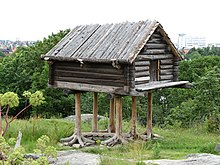
Baba Yaga is an enigmatic or ambiguous character from Slavic folklore who has two opposite roles. In some motifs she is described as a repulsive or ferocious-looking old woman who fries and eats children, while in others she is a nice old woman, who helps out the hero. She is often associated with forest wildlife. Her distinctive traits are flying around in a mortar, wielding a pestle, and dwelling deep in the forest in a hut standing on chicken legs.
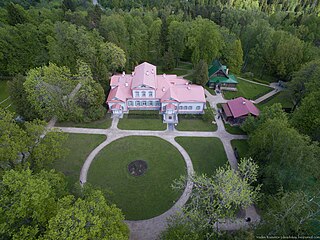
Abramtsevo is a former country estate and now museum-reserve located north of Moscow, in the proximity of Khotkovo, that became a centre for the Slavophile movement and an artists' colony in the 19th century. The estate is located in the village of Abramtsevo, in Sergiyevo-Posadsky District of Moscow Oblast. The Abramtsevo Museum-reserve site is an object of cultural heritage in Russia.

The Tale of Tsar Saltan, of His Son the Renowned and Mighty Bogatyr Prince Gvidon Saltanovich and of the Beautiful Swan-Princess is an 1831 fairy tale in verse by Alexander Pushkin.

Julian Alexandrovich Scriabin was a Swiss-born Russian composer and pianist who was the youngest son of Alexander Scriabin and Tatiana de Schloezer.
The Wicked Sisters is a Russian fairy tale collected by Alexander Afanasyev in Narodnye russkie skazki.

The Feather of Finist the Falcon or Finist the Falcon is a Russian fairy tale collected by Alexander Afanasyev in Narodnye russkie skazki. It is Aarne–Thompson type 432, the prince as bird. Other tales of this type include The Green Knight, The Blue Bird, and The Greenish Bird. Variants of the tale are primarily known in Russia and among the Komi.
The Battle of Konotop or Battle of Sosnivka was fought between a coalition led by the Hetman of Ukrainian Cossacks Ivan Vyhovsky and cavalry units of the Russian Tsardom under the command of Semyon Pozharsky and Semyon Lvov, supported by Cossacks of Ivan Bezpaly, on 29 June 1659, near the town of Konotop, Ukraine, during the Russo-Polish War (1654–1667). Vyhovsky's coalition defeated the Russians and their allies and forced the main Russian army to interrupt the siege of Konotop. However, the result of the battle only intensified political tensions in Ukraine and led to Vyhovsky's removal from power several months later.
Oleg Nikolayevich Trubachyov was a Russian linguist. A researcher of the etymology of Slavic languages and Slavic onomastics, he was considered a specialist in historical linguistics and lexicography. He was a Doctor of Sciences in Philological Sciences, an academician of the Russian Academy of Sciences and served as the editor-in-chief of the Etimologiya yearbook. His works are on the etymology of Slavic languages and on East Slavic onomastics.
Galashki is a rural locality in Sunzhensky District of the Republic of Ingushetia, Russia, located on the left bank of the Sunzha River near the border with the Republic of North Ossetia–Alania. Its population was about 9,000 people in 2009. Galashki forms the municipality of the rural settlement of Galashki as the only settlement in its composition.
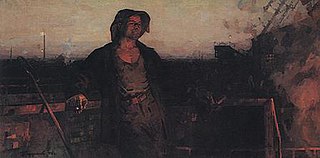
The All-Union Art Exhibition Dedicated to the 40th Anniversary of the Great October Socialist Revolution was one of the largest art exhibitions in Soviet history. Exhibition took place in Manezh Exhibition Hall from November 5, 1957, to May 1958.

Tatiana Valerianovna Dorofeeva was a Russian linguist, orientalist and translator.
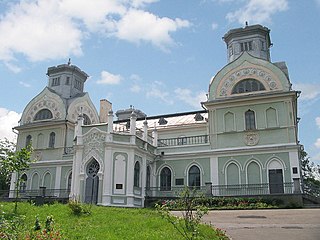
The Lopukhin family was a noble family of the Russian Empire, forming one of the branches of the Sorokoumov-Glebov family.
Anton Loginov was a Russian Bolshevik Revolutionary, Communist Party member, journalist, writer, Soviet publicist, and propagandist of atheism.
Mark Mendelevich Persits was a Soviet propagandist of atheism, a scientific worker in the study of problems of religion and atheism, a writer, and a historian of social thought.
Ivan Aleksandrovich Flerov was a Soviet educator, journalist, and proponent of atheism.
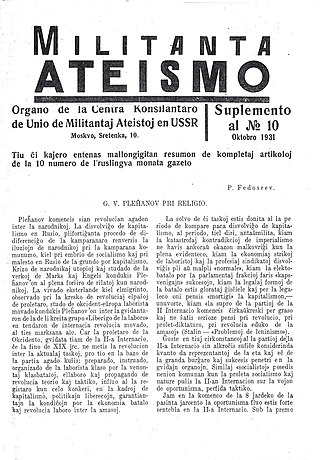
Voinstvuiuschii ateizm was an antireligious monthly magazine in Russian, German, and Esperanto, which was published from January to December of 1931, in the USSR.

Derevenskiy Bezbozhnik was an illustrated magazine, an organ of the Centre Soviet and Moscow Oblast Soviet of the League of the Militant Godless.
Konstantin Vasilyevich Dushenko is a Russian translator, culturologist and historian, with the Institute of Scientific Information on Social Sciences of the Russian Academy of Sciences. He authored over 30 books on the origins of various quotations, aphorisms, and bon mots.
The Tale about Baba-Yaga is a Russian fairy tale first published in a late 18th-century compilation of fairy tales.
The Faraway Tsardom is an undefined realm of East Slavic folklore into which the hero fell or separated from the ordinary world by an impenetrable dense forests, abysses, seas or other obstacles. In Russian language it is referred to as Тридевятое царство, тридесятое царство.


